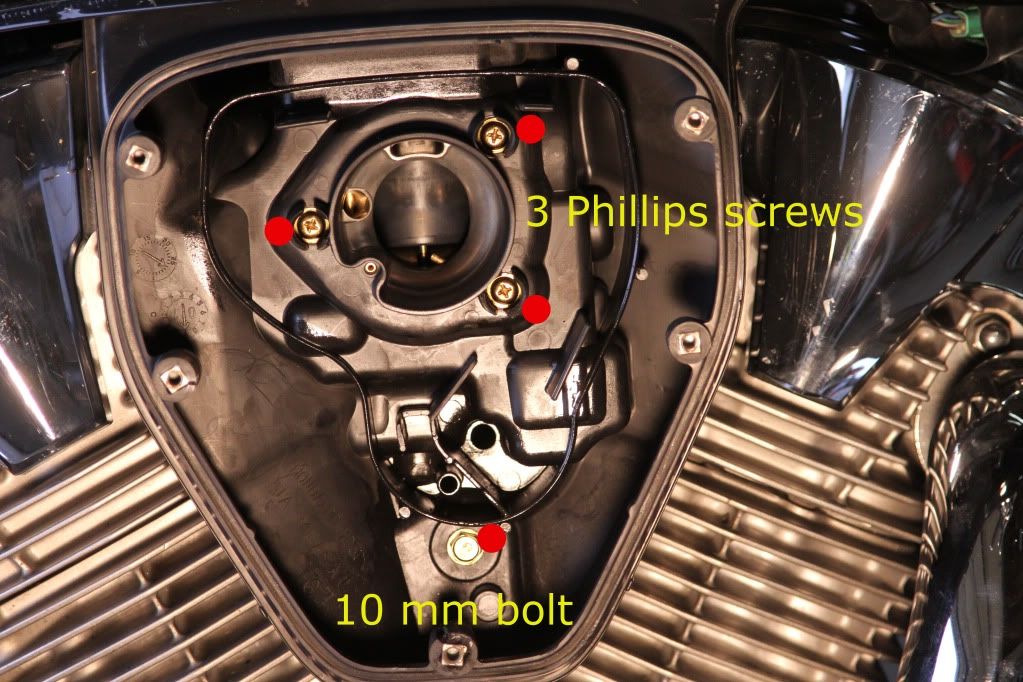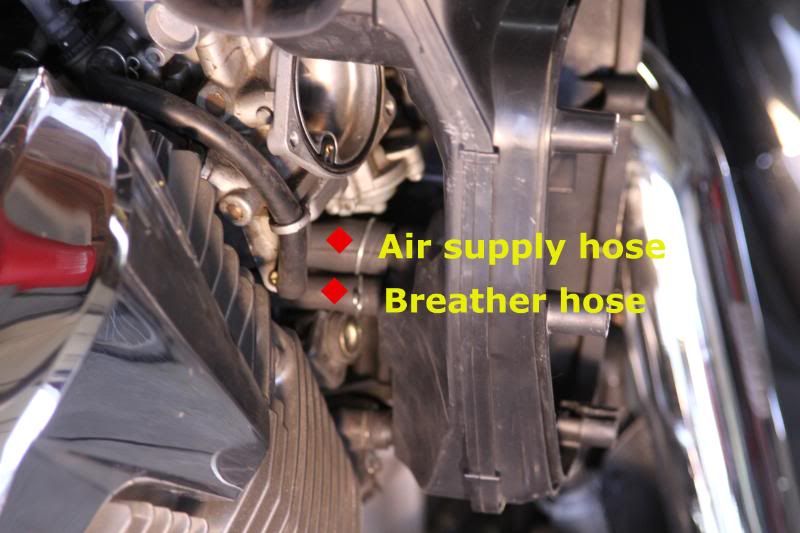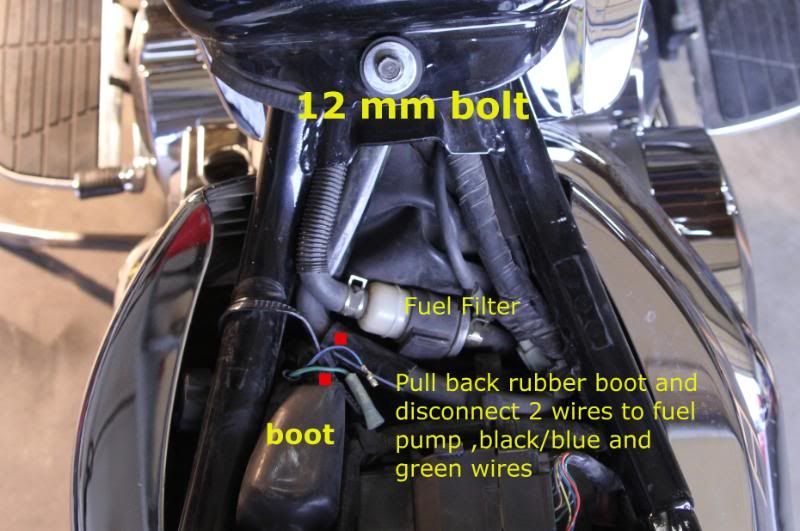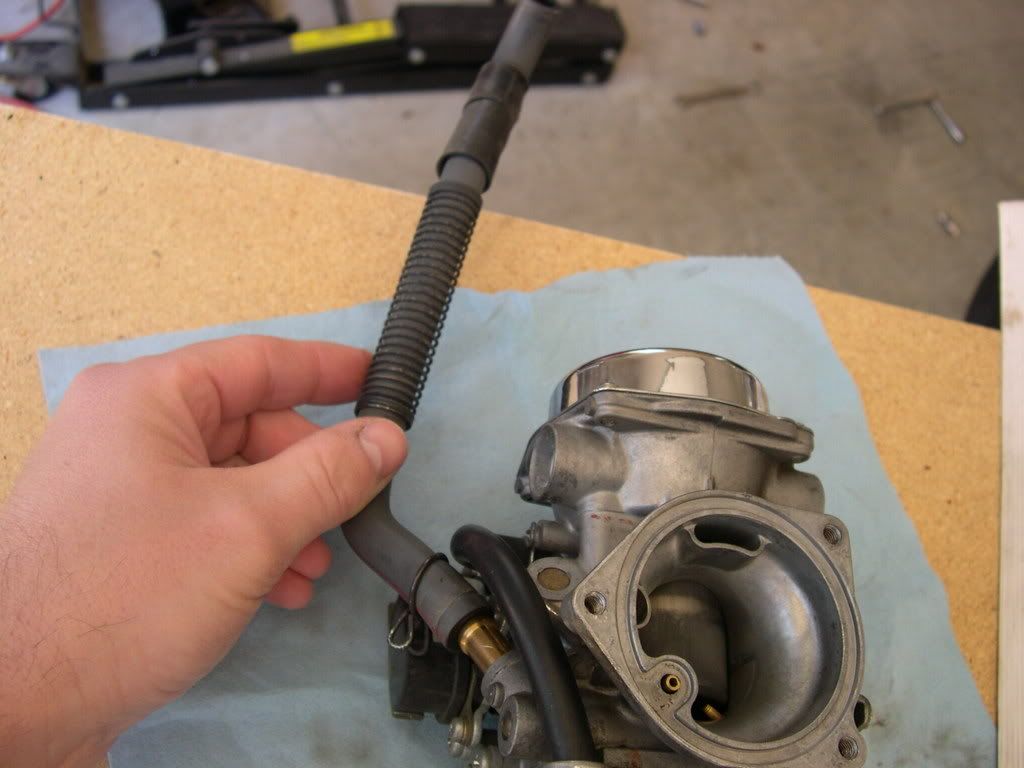OK, straight to the point -- for those running the "heavy breather" mods.
Keihin stock 195 main jet
Keihin stock needle, three shims (.06")
2 1/2 turns out on the A/F screw
Cut the slider spring to 5 1/16"
Details to follow for those that are not carb "savvy" -- NOTE: Fine tuning to come, but these settings will get you on the road and "running good" (and save money).
Now, down to the "basics"
I have wondered why so many people have been having problems dialing in their intake/exhaust systems via the carb circuit and took a little time to look at it a little closer today while experimenting with the stock Keihin needles (and yes, first reports are that they "ROCK") -- Those Japanese engineers knew what they were doing when they designed this 38mm carb, and there are some "tell tail" signs that they may have left for "performance" tuning when ordering the machining of parts that will be covered.
First of all... I have read several times about trimming the protruding tip under the "needle holder"... well, IT HAS TO BE DONE... just do it.. cut it in half with toenail clippers (the big ones, not the small fingernail clippers).. then put your toenail clippers in your tool box so they are there when you fix your buddies bike. Reason: If you run the dyno jet needle on the forth clip (or the stock Keihin needle with three shims or more as will be explained later) THE NEEDLE PUSHES AGAINST THE NEEDLE HOLDER AND DOES NOT ALLOW THE NEEDLE TO OPERATE FREELY. If you currently have the needle set like this, when you pull the slider piston from the carb body, try and "shake" the needle... IT IS STIFF ... no movement... this will mess you up -- the sides of the jet will be elongated AND the needle will not slide freely and you will wonder why you are not able to tune the bike properly... that needle has to be able to "shake around" freely when the slider piston is moving up and down -- If you EVER move the needle "up" to a position where the needle will not "shake" around once the needle holder is installed, cut more off of that "tip"... you will still have enough left to "screw" the spring onto it... but the needle movement has to be FREE.
Now, shimming the needle... That is a beautiful needle isn't it?? I have worked with a few different needles and the tapered variety is definitely the most intriguing not to mention delivering the most predictably metered fuel supply... if you compare it to the DJ needle you will notice that the Keihin is "swagged" (for want of a better term) and this may be to compensate for the nominal power drop commonly encountered with many systems in the mid range... this has been minimized with this needle design.. notice where the "swag" is most predominately exaggerated. Also notice that near the top of the "needle" there is a machining "groove" then under that there is yet another machining groove... well coincidently that first machining groove figures out to about .06" below the bottom of the needle head. Could it be an "indicator" from the engineer that even tho from the factory the carb meet EPA tuning requirements/emissions that carb performance would be maximized if shimmed to this point?? Who knows, but if you put a DJ needle running the 4th notch next to the Keihin needle, they match up at that point.. interesting... (don't forget to trim the tip under the needle holder to accommodate for this setting).
If you place three Radio Shack shims (or similar shims, equaling .06") under the needle head, then you should have a good starting point for a bike running fairly free breathing exhaust and intake... if you are running something slightly less than that, then use less shims... more shims equal more fuel... the APPROXIMATE fuel delivery of a Keihin 195 main jet is 195 cc/min and can be regulated with the height of the needle in the jet.
As always, the Keihin 55 Pilot Jet is most likely sufficient for maximum performance/tuning and the tuning procedure should be 2 1/2 turns out from the closed position during the entire tuning of the main jet process... if necessary the Pilot Jet can be "touched up" after the proper main jet tuning has been accomplished.
This is a "ballpark" tuning procedure and will get you on the road with a good performing bike.. fine tuning can be accomplished through following the steps as outlined by Factory Pro CV Carb Tuning Procedures -- Follow the steps religiously and you should have no problems.
RESPONSE: Most "tuners" run a shorter piston slider spring than comes in the factory stock equipment. If the factory spring is cut to 5 1/16" it should approximate the reaction time of the shorter spring that is supplied with the dyno jet kit... the factory spring appears to be marginally stiffer than the after market product, so this leaves a slight margin of error... if you are nervous about cutting slider springs, new ones can be had for a nominal fee from places such as ronayers.com: Online Shopping Motorsports Parts -- (Most people recommend placing the cut end of the spring down inside the slider tube and the uncut end "UP" into the underside of the cap/cover) Well, that just about concludes the elcheapo mod for making the bike run properly.
It would appear that the carb engineers at Keihin actually knew what they were doing. The factory jet may supply something close to what optimum performance is for the 38mm carb, if nothing else it will equate the performance of a straight cut 210mm main jet in fuel delivery if properly shimmed.
Larger jets of the Keihin shape can be bought through "Factory Pro" and after fine tuning, if it is evident that I require such jets, there will be a "write up" on that also. To date the bike pulls pretty good up to 83mph indicated in second gear. If there are some out there that require more than the Keihin 195 with the Keihin needle, they could order these jets... drilling is always an option, but this write up is not intended for the advanced tuner. -- Good luck and good riding.
Keihin stock 195 main jet
Keihin stock needle, three shims (.06")
2 1/2 turns out on the A/F screw
Cut the slider spring to 5 1/16"
Details to follow for those that are not carb "savvy" -- NOTE: Fine tuning to come, but these settings will get you on the road and "running good" (and save money).
Now, down to the "basics"
I have wondered why so many people have been having problems dialing in their intake/exhaust systems via the carb circuit and took a little time to look at it a little closer today while experimenting with the stock Keihin needles (and yes, first reports are that they "ROCK") -- Those Japanese engineers knew what they were doing when they designed this 38mm carb, and there are some "tell tail" signs that they may have left for "performance" tuning when ordering the machining of parts that will be covered.
First of all... I have read several times about trimming the protruding tip under the "needle holder"... well, IT HAS TO BE DONE... just do it.. cut it in half with toenail clippers (the big ones, not the small fingernail clippers).. then put your toenail clippers in your tool box so they are there when you fix your buddies bike. Reason: If you run the dyno jet needle on the forth clip (or the stock Keihin needle with three shims or more as will be explained later) THE NEEDLE PUSHES AGAINST THE NEEDLE HOLDER AND DOES NOT ALLOW THE NEEDLE TO OPERATE FREELY. If you currently have the needle set like this, when you pull the slider piston from the carb body, try and "shake" the needle... IT IS STIFF ... no movement... this will mess you up -- the sides of the jet will be elongated AND the needle will not slide freely and you will wonder why you are not able to tune the bike properly... that needle has to be able to "shake around" freely when the slider piston is moving up and down -- If you EVER move the needle "up" to a position where the needle will not "shake" around once the needle holder is installed, cut more off of that "tip"... you will still have enough left to "screw" the spring onto it... but the needle movement has to be FREE.
Now, shimming the needle... That is a beautiful needle isn't it?? I have worked with a few different needles and the tapered variety is definitely the most intriguing not to mention delivering the most predictably metered fuel supply... if you compare it to the DJ needle you will notice that the Keihin is "swagged" (for want of a better term) and this may be to compensate for the nominal power drop commonly encountered with many systems in the mid range... this has been minimized with this needle design.. notice where the "swag" is most predominately exaggerated. Also notice that near the top of the "needle" there is a machining "groove" then under that there is yet another machining groove... well coincidently that first machining groove figures out to about .06" below the bottom of the needle head. Could it be an "indicator" from the engineer that even tho from the factory the carb meet EPA tuning requirements/emissions that carb performance would be maximized if shimmed to this point?? Who knows, but if you put a DJ needle running the 4th notch next to the Keihin needle, they match up at that point.. interesting... (don't forget to trim the tip under the needle holder to accommodate for this setting).
If you place three Radio Shack shims (or similar shims, equaling .06") under the needle head, then you should have a good starting point for a bike running fairly free breathing exhaust and intake... if you are running something slightly less than that, then use less shims... more shims equal more fuel... the APPROXIMATE fuel delivery of a Keihin 195 main jet is 195 cc/min and can be regulated with the height of the needle in the jet.
As always, the Keihin 55 Pilot Jet is most likely sufficient for maximum performance/tuning and the tuning procedure should be 2 1/2 turns out from the closed position during the entire tuning of the main jet process... if necessary the Pilot Jet can be "touched up" after the proper main jet tuning has been accomplished.
This is a "ballpark" tuning procedure and will get you on the road with a good performing bike.. fine tuning can be accomplished through following the steps as outlined by Factory Pro CV Carb Tuning Procedures -- Follow the steps religiously and you should have no problems.
RESPONSE: Most "tuners" run a shorter piston slider spring than comes in the factory stock equipment. If the factory spring is cut to 5 1/16" it should approximate the reaction time of the shorter spring that is supplied with the dyno jet kit... the factory spring appears to be marginally stiffer than the after market product, so this leaves a slight margin of error... if you are nervous about cutting slider springs, new ones can be had for a nominal fee from places such as ronayers.com: Online Shopping Motorsports Parts -- (Most people recommend placing the cut end of the spring down inside the slider tube and the uncut end "UP" into the underside of the cap/cover) Well, that just about concludes the elcheapo mod for making the bike run properly.
It would appear that the carb engineers at Keihin actually knew what they were doing. The factory jet may supply something close to what optimum performance is for the 38mm carb, if nothing else it will equate the performance of a straight cut 210mm main jet in fuel delivery if properly shimmed.
Larger jets of the Keihin shape can be bought through "Factory Pro" and after fine tuning, if it is evident that I require such jets, there will be a "write up" on that also. To date the bike pulls pretty good up to 83mph indicated in second gear. If there are some out there that require more than the Keihin 195 with the Keihin needle, they could order these jets... drilling is always an option, but this write up is not intended for the advanced tuner. -- Good luck and good riding.



















































